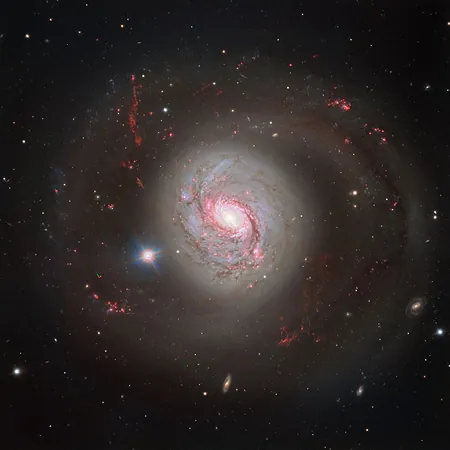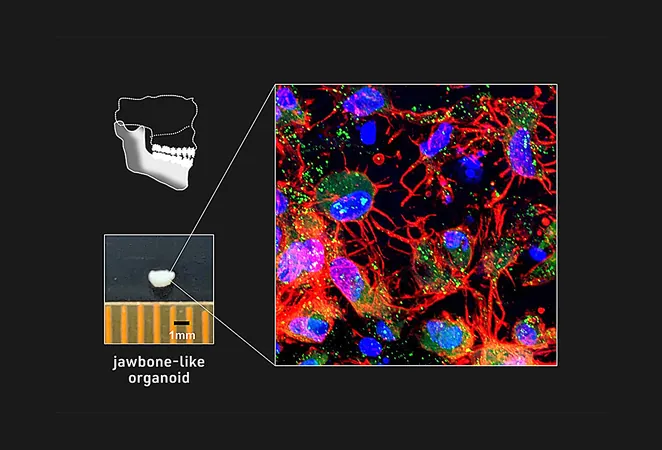
Astronomers Unveil Stunning New Details of Supermassive Black Hole's Activity!
2025-01-17
Author: Nur
Groundbreaking Advances in Astrophysics
In a groundbreaking advance in astrophysics, astronomers have achieved the highest resolution infrared images ever captured of an active galactic nucleus (AGN), which is essentially a supermassive black hole at the center of certain galaxies. These black holes generate staggering amounts of energy when surrounding matter is consumed, making AGNs some of the most powerful phenomena in the cosmos.
Collaboration and Methodology
Researchers from the University of Arizona, in collaboration with the Max Planck Institute for Astronomy in Germany, leveraged the advanced capabilities of the Large Binocular Telescope Interferometer (LBTI). Their exciting findings, now published in the prestigious journal *Nature Astronomy*, offer fresh insights into the dynamic environments of AGNs.
Jacob Isbell, a postdoctoral research associate at the U of A's Steward Observatory and the lead author, remarked on the significance of this achievement: "The Large Binocular Telescope Interferometer can be considered the first extremely large telescope, which makes this breakthrough particularly thrilling."
Understanding Active and Dormant Black Holes
Each galaxy is home to a supermassive black hole, some classified as active and some as dormant, depending on the inflow of matter. The surrounding disk that forms around these black holes grows brighter as more material accumulates, leading to the categorization of an "active" supermassive black hole. The AGN in galaxy NGC 1068, located near our Milky Way, is one of the closest active black holes known.
Innovative Telescope Technology
Utilizing its unique dual 8.4-meter mirrors, the Large Binocular Telescope, situated on Mount Graham in Arizona, functions effectively as two telescopes operating side by side. The innovative interferometric technique combines data from both mirrors, achieving much sharper insights than either could accomplish alone. In previous successes, this technique has provided detailed observations of phenomena such as volcanic activity on Jupiter’s moon Io.
Significant Findings
"The brightness of the AGN in NGC 1068 made it an ideal candidate for our study," Isbell noted. "These images represent the highest resolution direct observations of an AGN captured to date."
Led by Steve Ertel, an associate astronomer at Steward Observatory, the LBT Interferometer team observed multiple cosmic activities simultaneously within the AGN. Remarkably, the bright disk encircling the supermassive black hole generates radiation pressure powerful enough to push away surrounding dust, demonstrating how cosmic winds can be influenced by the black hole's activity.
Unveiling Cosmic Interactions
The team's images unveiled a dusty outflow wind driven by this radiation pressure, alongside an unexpectedly bright material layer further out, which appeared over-illuminated by the highly energetic accretion disk. By comparing these new observations with historical data, researchers linked this brightness to a radio jet protruding from the supermassive black hole, which interacts with and heats surrounding clouds of gas and dust—an effect known as radio jet feedback.
Future Prospects in Astronomy
With the ability to distinguish between different cosmic phenomena—thanks to the high resolution of telescopes like the LBTI and the upcoming Giant Magellan Telescope in Chile—scientists can now analyze the effects of powerful jets and dusty winds independently. Previously blended processes can now be studied with unprecedented clarity, revealing the complex nature of AGNs and their roles within their host galaxies.
"This kind of imaging is incredibly versatile and can be applied to various astronomical objects," Isbell stated. "We’ve already begun examining disks around stars, particularly large, evolved stars enveloped in dust."
Conclusion and Future Updates
The revelations from this study not only illuminate the activities of supermassive black holes but also open new avenues for understanding the intricate interactions between AGNs and the galaxies they inhabit. Don't miss future updates on cosmic discoveries that reshape our understanding of the universe!



 Brasil (PT)
Brasil (PT)
 Canada (EN)
Canada (EN)
 Chile (ES)
Chile (ES)
 Česko (CS)
Česko (CS)
 대한민국 (KO)
대한민국 (KO)
 España (ES)
España (ES)
 France (FR)
France (FR)
 Hong Kong (EN)
Hong Kong (EN)
 Italia (IT)
Italia (IT)
 日本 (JA)
日本 (JA)
 Magyarország (HU)
Magyarország (HU)
 Norge (NO)
Norge (NO)
 Polska (PL)
Polska (PL)
 Schweiz (DE)
Schweiz (DE)
 Singapore (EN)
Singapore (EN)
 Sverige (SV)
Sverige (SV)
 Suomi (FI)
Suomi (FI)
 Türkiye (TR)
Türkiye (TR)
 الإمارات العربية المتحدة (AR)
الإمارات العربية المتحدة (AR)